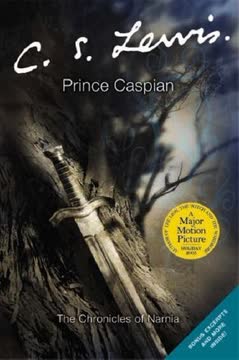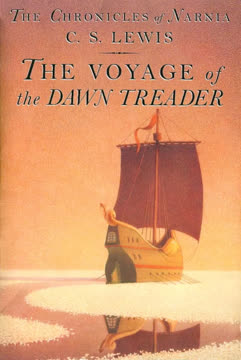Plot Summary
Summoned from the Station
Peter, Susan, Edmund, and Lucy, once kings and queens in Narnia, are unexpectedly pulled from a mundane train station in England back into a mysterious, overgrown world. Disoriented, they find themselves on a wild island, surrounded by ruins and hints of a lost past. The siblings' initial confusion gives way to the realization that they have returned to Narnia, but everything is changed—ancient, abandoned, and unfamiliar. Their sense of adventure is tinged with nostalgia and loss, as they search for food and water, and begin to piece together the mystery of where—and when—they have arrived. The magic that once made Narnia vibrant now feels distant, and the children sense that their return is not by accident, but by urgent need.
Ruins of Forgotten Glory
Exploring the island, the children stumble upon the ruins of Cair Paravel, their former castle, now overtaken by nature and time. The once-glorious halls are reduced to crumbling walls and overgrown orchards, evoking bittersweet memories of their reign. In the ancient treasure chamber, they recover their old gifts—Peter's sword and shield, Susan's bow, Lucy's healing cordial—symbols of their former power and responsibility. The realization that centuries have passed in Narnia while only a year has gone by in England fills them with awe and sorrow. The weight of history presses upon them, and they sense that Narnia's fate is once again entwined with their own.
The Dwarf's Tale
The children rescue a dwarf, Trumpkin, from drowning, and he becomes their guide and storyteller. Over a meal of foraged fish, Trumpkin recounts the dire state of Narnia: the land is ruled by the tyrant Miraz, who has driven the magical creatures into hiding and suppressed all memory of Old Narnia. Trumpkin introduces the children to the rebellion led by Prince Caspian, a Telmarine royal who has turned against his own people to fight for the freedom of Narnia's original inhabitants. The children learn that their return was summoned by the blowing of Queen Susan's magical horn, a desperate call for help in Narnia's darkest hour.
Caspian's Secret Heritage
Prince Caspian, raised in the court of his usurping uncle Miraz, grows up enchanted by tales of Old Narnia—talking beasts, fauns, and Aslan the Lion—told to him by his nurse and later by his half-dwarf tutor, Doctor Cornelius. When Miraz's own son is born, Caspian's life is threatened, and Cornelius helps him escape with Susan's horn and the knowledge that he is the rightful king. Caspian's journey is one of awakening: he discovers his true heritage, the injustices of his people, and the hope that the old magic and Aslan might yet return to save Narnia.
Flight and New Allies
Fleeing Miraz's assassins, Caspian is injured and rescued by Trufflehunter the badger and the dwarfs Trumpkin and Nikabrik. Initially mistrusted, Caspian wins their loyalty by revealing his knowledge of Old Narnia and his desire to restore it. Together, they seek out the hidden creatures of legend—bulgy bears, talking mice, centaurs, and fauns—who have survived in secrecy. Caspian's leadership unites these disparate beings, and he is accepted as the true king by those who remember the old ways. The alliance is fragile, threatened by fear, suspicion, and the overwhelming might of Miraz's forces.
Gathering Old Narnia
Caspian and his companions travel the wilds, gathering support from the scattered remnants of Old Narnia. They encounter talking animals, dwarfs, centaurs, and even the valiant mouse Reepicheep, each pledging loyalty to Caspian's cause. The council at Dancing Lawn is a moment of hope and unity, as the old magic stirs and the creatures of legend come out of hiding. Yet, the threat of Miraz's army looms, and the Narnians are forced to retreat to Aslan's How, a sacred mound built over the Stone Table, to make their last stand.
Council at Dancing Lawn
At the council, the Narnians debate their desperate situation. Doctor Cornelius warns that Miraz's army is closing in, and the group must flee to Aslan's How for safety. The mood is tense, with old grievances and doubts surfacing. Some, like Nikabrik, are willing to turn to any power—even the White Witch—for salvation, while others cling to faith in Aslan and the old kings. The blowing of Susan's horn is decided as their last hope, a magical plea for help that will summon aid from beyond Narnia's borders.
Horn of Desperate Hope
As Caspian's forces are besieged and hope fades, he blows Susan's horn. The magic of the horn transcends time and space, pulling Peter, Susan, Edmund, and Lucy from England into Narnia. Trumpkin is sent to seek the help the horn might bring, leading to his encounter with the children. The narrative threads of past and present converge, as the old kings and queens are drawn back to fulfill the ancient prophecy and answer Narnia's call.
The Children's Return
Guided by Trumpkin, the children set out to find Caspian and the besieged Narnians. Their journey is fraught with hardship—hunger, exhaustion, and the dangers of a wild, changed land. They must prove themselves to Trumpkin, who doubts their abilities, through contests of skill and courage. The children's transformation from ordinary English schoolchildren to the legendary rulers of Narnia is gradual but profound, as they reclaim their old strengths and sense of purpose.
Lost in the Wild Woods
The children become lost in the dense, altered forests of Narnia, their confidence shaken. Lucy alone sees Aslan, who urges her to lead the others, but her siblings doubt her vision. The group's unity is tested by fatigue, fear, and disagreement. The theme of faith versus skepticism emerges, as Lucy must choose whether to follow Aslan's guidance even if she must go alone. The emotional tension peaks as the children vote to follow the safer path, leaving Lucy in tears and doubt.
Aslan's Silent Guidance
Aslan appears to Lucy again, encouraging her to persist in faith and leadership. Gradually, the others begin to see Aslan as well, and their spirits are renewed. Aslan's presence awakens the sleeping magic of Narnia: trees dance, rivers sing, and the land itself comes alive. The children's journey becomes a procession of joy and restoration, as Aslan leads them toward the final confrontation. The Lion's guidance is both gentle and demanding, requiring trust, courage, and humility from his followers.
Treachery in the How
Inside Aslan's How, tensions erupt as Nikabrik, desperate and embittered, conspires with a hag and a werewolf to summon the White Witch. Caspian, Trufflehunter, and Doctor Cornelius resist, and a violent struggle ensues. Peter, Edmund, and Trumpkin arrive in time to prevent disaster, but not before Nikabrik and his allies are slain. The episode is a stark warning of the dangers of despair and the temptation to seek power at any cost. The unity of the Narnians is preserved, but at a heavy price.
The High King's Challenge
With Aslan's return still uncertain, Peter proposes a challenge of single combat to Miraz, hoping to buy time and inspire the Narnians. Miraz, goaded by his own lords, accepts. The duel is a tense, brutal contest, watched by both armies and the newly awakened spirits of Narnia. Peter fights valiantly, embodying the honor and chivalry of the old kings, while Miraz is undone by treachery from his own followers. The outcome shifts the balance of power and sets the stage for the final battle.
Battle and Awakening
As the duel ends, Miraz's lords betray and kill him, plunging the Telmarines into chaos. The Narnians, led by Peter, Caspian, and the awakened trees and river gods, rout the enemy. Aslan, accompanied by Bacchus and the Maenads, unleashes a wild, joyous magic that transforms the land and its people. The bridge at Beruna is destroyed, the Telmarines are defeated, and Narnia is reborn in a riot of celebration, freedom, and forgiveness. The old wounds begin to heal as the true king is crowned.
Aslan's Doorway Home
With peace restored, Aslan offers the Telmarines a choice: remain in Narnia or return to their ancestral world through a magical doorway. Caspian is crowned king, and the children are honored for their courage and sacrifice. Aslan reveals that Peter and Susan will not return to Narnia, as they are growing up, while Edmund and Lucy may yet come again. The children bid tearful farewells to their friends and to Aslan, stepping through the door and back into their own world. The story ends with a sense of closure and hope, as Narnia's golden age is renewed and the children carry its lessons with them.
Characters
Peter Pevensie
Peter is the eldest of the Pevensie siblings and the High King of Narnia. He embodies courage, responsibility, and a deep sense of honor. Peter's journey in this story is one of reclaiming lost authority and learning humility; he must lead not only in battle but also in moments of doubt and division. His challenge to Miraz is both a strategic move and a test of his own worthiness. Peter's maturity is evident in his willingness to step aside for Caspian and to accept that his time in Narnia is ending. His relationship with his siblings is protective but sometimes strained by the burdens of leadership.
Susan Pevensie
Susan, the second eldest, is known for her archery skills and her level-headedness. She often acts as the voice of reason, sometimes to the point of skepticism. Susan's reluctance to believe in Aslan's presence and her struggle with faith are central to her character arc. She is nurturing toward Lucy and supportive of her brothers, but her practicality can make her resistant to the magic and wonder of Narnia. Susan's journey is one of learning to trust beyond what she can see, and her eventual acceptance of Aslan's guidance is both humbling and redemptive.
Edmund Pevensie
Edmund, once a traitor in the first Narnia story, is now a voice of fairness and support, especially for Lucy. He is quick to recall his own past mistakes and is more willing than the others to believe in the unseen. Edmund's growth is marked by humility, self-awareness, and a quiet strength. He acts as a mediator in conflicts and is willing to challenge Peter or Susan when he believes they are wrong. Edmund's loyalty to his siblings and to Narnia is unwavering, and he proves himself in both word and deed.
Lucy Pevensie
Lucy, the youngest, is the most attuned to Narnia's magic and to Aslan's presence. Her faith is childlike but profound, allowing her to see and follow Aslan when others cannot. Lucy's journey is one of perseverance in the face of doubt and loneliness; she must lead her older siblings even when they dismiss her visions. Her compassion, courage, and unwavering belief are the emotional core of the story, and her relationship with Aslan is intimate and transformative. Lucy's innocence is not naivety, but a source of strength and renewal for all.
Prince Caspian
Caspian is a young prince raised in ignorance of his true heritage and the wonders of Old Narnia. His longing for the lost magic and justice of the past drives him to rebel against his uncle Miraz. Caspian's character is defined by humility, curiosity, and a willingness to learn from others. He unites the diverse peoples of Narnia, earning their trust through empathy and vision. Caspian's growth from sheltered boy to wise king is central to the narrative, and his willingness to accept help and guidance marks him as a true leader.
Trumpkin
Trumpkin is a red dwarf who initially doubts the old legends and the power of magic. He is practical, brave, and fiercely loyal to Caspian and the cause of Old Narnia. Trumpkin's skepticism is challenged by the arrival of the Pevensies and the return of Aslan, leading to a reluctant but genuine transformation. He provides comic relief, grounded wisdom, and a counterpoint to the more idealistic characters. Trumpkin's journey is one of learning to believe in what he cannot see, and his loyalty is ultimately rewarded.
Trufflehunter
Trufflehunter is the oldest and kindest of Caspian's early allies, a talking badger who never loses faith in Aslan or the old ways. He is a stabilizing force, advocating for patience, unity, and hope even in the darkest times. Trufflehunter's steadfastness contrasts with the cynicism of others, and his memory of Narnia's true nature is a guiding light for the rebellion. He is nurturing, wise, and deeply committed to the restoration of Narnia.
Nikabrik
Nikabrik is a black dwarf whose suffering and hatred have twisted him into a dangerous figure. His willingness to ally with dark forces, including the White Witch, stems from desperation and a sense of betrayal. Nikabrik's character is a cautionary tale about the corrosive power of bitterness and the temptation to seek power at any cost. His actions nearly doom the rebellion, and his death is both tragic and necessary for Narnia's renewal.
Doctor Cornelius
Doctor Cornelius is Caspian's tutor, a learned and gentle half-dwarf who preserves the knowledge of Old Narnia. He guides Caspian's awakening, risking his life to reveal the truth and help him escape. Cornelius is wise, cautious, and deeply loyal, serving as a bridge between the old and new worlds. His magic and scholarship are vital to the rebellion, and his presence is a source of comfort and counsel.
Reepicheep
Reepicheep is the leader of the talking mice, renowned for his courage, chivalry, and fierce pride. Though small in stature, he is a formidable warrior and a source of inspiration to all. Reepicheep's sense of honor is both his strength and his vulnerability, as seen in his distress over the loss of his tail. His loyalty to Caspian and Aslan is absolute, and his actions in battle are both heroic and endearing. Reepicheep represents the idea that true nobility comes from the heart, not from size or power.
Plot Devices
Time Dilation and Lost Ages
The children's return to a Narnia centuries older than they remember is a powerful device, evoking themes of loss, change, and the persistence of memory. This time gap allows for the rise of new conflicts and the fading of old glories, making the children both legendary figures and strangers in their own land. The device heightens the sense of wonder and melancholy, as the past is both present and irretrievable.
Magical Summoning and Prophecy
Susan's horn, a gift from Aslan, serves as the catalyst for the children's return and the convergence of destinies. Its magic is both literal and symbolic, representing hope, faith, and the power of belief. The prophecy of the return of the old kings and queens underpins the narrative, driving characters to acts of courage and desperation.
Dual Narratives and Flashbacks
The narrative alternates between the children's journey and Caspian's backstory, gradually revealing the stakes and the interconnectedness of their fates. Trumpkin's storytelling bridges the gap, allowing readers to experience both the immediacy of the present crisis and the depth of Narnia's history. This structure builds suspense and emotional resonance.
Faith, Doubt, and Vision
The motif of seeing or not seeing Aslan reflects the characters' inner struggles with faith, trust, and leadership. Lucy's ability to perceive Aslan when others cannot is both a gift and a burden, challenging the group to follow what cannot be proven. This device explores the tension between reason and intuition, and the necessity of courage in the face of uncertainty.
Betrayal and Redemption
Nikabrik's plot to summon the White Witch introduces the theme of moral compromise and the dangers of despair. The story warns against seeking power through evil means, even for a good cause, and contrasts this with the redemptive power of unity, forgiveness, and self-sacrifice. The ultimate victory is achieved not through force alone, but through the restoration of faith and the renewal of Narnia's true spirit.
Analysis
Prince Caspian is a story of restoration, faith, and the enduring struggle between tyranny and freedom. C.S. Lewis crafts a narrative that is both a thrilling adventure and a meditation on the nature of belief, leadership, and the passage of time. The return of the Pevensie children to a changed Narnia underscores the pain of lost innocence and the challenge of reclaiming what is good in a world that has forgotten its own magic. The novel explores the necessity of hope in the face of overwhelming odds, the dangers of cynicism and despair, and the transformative power of humility and courage. Aslan's role as a silent guide reflects the idea that true leadership requires trust in something greater than oneself, and that renewal often comes through the least expected means. The story's conclusion, with its bittersweet farewells and the promise of new beginnings, invites readers to consider the cycles of history, the importance of memory, and the possibility of redemption. In a modern context, Prince Caspian speaks to the need for unity across differences, the courage to resist oppression, and the faith to pursue justice even when the path is unclear.
Last updated:
Review Summary
Prince Caspian is generally well-received by readers, praised for its magical world-building and character development. Many appreciate the return of the Pevensie siblings and the introduction of new characters like Caspian. The book's themes of faith, courage, and good versus evil resonate with readers. Some find the pacing slower than the first book, and a few note dated elements. Overall, fans enjoy revisiting Narnia and its blend of adventure and moral lessons, though opinions vary on its place within the series.
The Chronicles of Narnia (Chronological Order) Series
Similar Books










Download PDF
Download EPUB
.epub digital book format is ideal for reading ebooks on phones, tablets, and e-readers.













